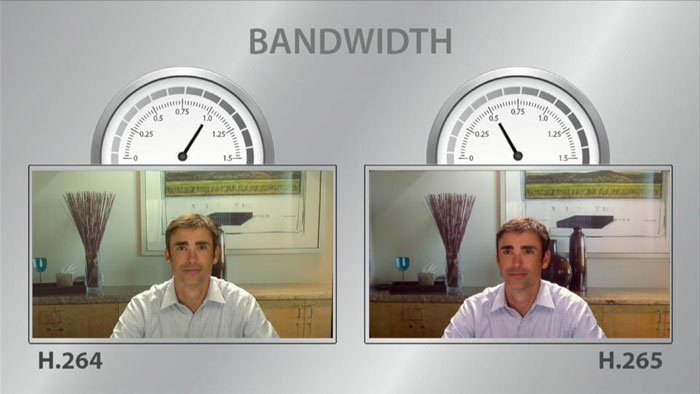
HEVC / H.265

Efficiency Video Coding (HEVC), H.265 is a new video compression standard, which produces videos of the same quality as H.264 yet taking up only half the bandwidth.
H.265/HEVC is critical for streaming high-quality video even in congested network environments, and will be a driving factor in the delivery of 4K content to new Ultra HD displays.



H.265 PK H.264, what’s the advantages of H.265?
-
Flexible coding structure
- In H.265, the size of macro block is explored from 16*16 to 64*64 for better compression of high-resolution video.
-
High coding efficiency
- At the same code rate, H.265 image will show higher definition in water plants details
-
What’s more?
- Compared with H.264, It is approximate 2X as effective as H.264, it can reduces file size up to 50% with the same quality, Supports resolution up to 7680 × 4320 (8K), Reduces video noise and increases dynamic range.
- An imbalance between cost and product features.
- Need devices to support H.265/ HEVC coding, improve the performance.
- This will depend on many factors — for example, how soon will graphics chips makers, such as AMD and NVIDIA, integrate H.265 into their products. The first generation of H.265 chipsets may be only suitable for initial video coding standards, and there are still many H.265 image processing functions, extensions, and multiview video coding that need to be enhanced.
-
Need Large-scale popularization.
- The current H.265 due to price reasons, now is only used by public security, transportation, government, telecommunications an financial industries, which required a high-resolution with Full HD quality.
- For other industries, most of them already have existing technologies and therefore would be hesitant to adopt H.265, which requires a longer verification period.
- There has a long way to go to reach Large-scale popularization. And now the H.264 is still the main-stream products. H.265 worth the expectation.
H.265 vs H.264 Compression Ratio & Bandwidth Utilization
H.265 has better compression performance and lower bandwidth utilization ratio.
For video services, the ultimate goal of compressing a movie is to reduce the size of the movie file, so as to take up less storage space, as well as drop the network bandwidth consumption in transmission.
Compared with H. 264, the greatest strength of H. 265 is that it has a higher compression ratio, which can be discerned from its name. H.265 is also called HEVC (High Efficiency Video Coding), and the primary use is to further reduce the design flow rate, in order to lower the cost of storage and transmission. At the same quality of coding, H. 265 can save around 50% of the bit rate, and coding efficiency can be doubled than H. 264. As H.265 provides more different tools to reduce the bit rate. For example, in H. 264, each macroblock is fixed to the size of 16 x16 pixels, but the coding unit of H.265 can be chosen from a minimum of 8 x 8 to the maximum of 64 x 64.


What’s the trend of H.265? Is it necessary and important for us to launch HEVC?
H.265 implementation has generated huge optimism given industry’s struggle with shortage of bandwidth, spectrum, storage, and imminent need to take growing HD content for multi-platform delivery. It can result in 20% investment savings, ensuring higher performance and lower network and system building cost in video surveillance. Implementation of the new format in video surveillance is “inevitable.” It will be a significant development for the future technological growth in HD surveillance.As HD 1080P TV broadcasting and 4K video streaming with H.265 are already possible, we are cautiously optimistic about the future of the H.265/HEVC standard. Therefore, MountXross will introduce H.265 products.
